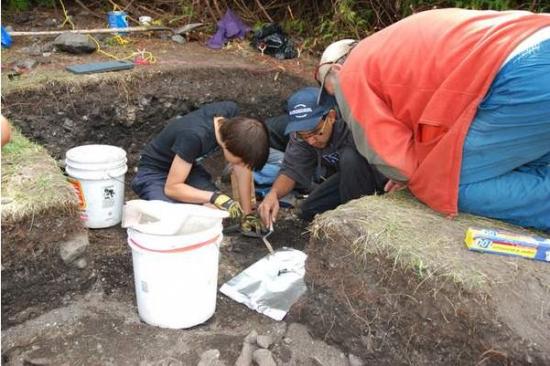SIB will fight to protect 4,000-year-old burial site
Christine Wood
Source - http://www.coastreporter.net/article/20120803/SECHELT0101/308039977/-1/sechelt/sib-will-fight-to-protect-4000-year-old-burial-site

SIB members Kurt Vader and Tyrone Joe-Mayes excavate pieces of charcoal to be used to carbon-date the newest burial site found at the mouth of Salmon Inlet. Gary Coupland, professor at the University of Toronto, oversees their work. See more photos in our on-line galleries at www.coastreporter.net. Christine Wood Photo
The Sechelt Nation will fight to save an ancient chieftain burial site found at the mouth of Salmon Inlet, described as one of the most important archeological discoveries in the province.
“We’ve proven without a shadow of a doubt this site is one of the most important in British Columbia — one of the most important for showing the development of chiefly status, and it’s right here,” Dr. Terence Clark of the Canadian Museum of Civilization said during Archeology Day at the Sechelt Indian Band (SIB) hall July 29.
He said archeologists have worked in the area every summer for the past three years through a partnership with the Sechelt Indian Band (SIB), the museum and the University of Toronto. Each year new burials and artifacts are found that point to the significance of the site.
Archeologists first discovered remains at the 4,000-year-old burial site in 2010, noting that the number of hand-crafted stone beads buried with the ancient man signalled his importance.
“With this individual, he was buried with about 350,000 stone beads, which is more than any other burial we’ve ever found from Alaska to California for any time period, so whoever this person was, this ancient Shishalh chief, he was very, very important in the greater scheme of the entire northwest coast,” Clark said, noting the beads likely adorned a chiefly robe that didn’t stand the test of time.
The following year archeologists found a young woman, estimated to be in her 20s, buried at the site with projectile points broken and arranged around her feet.
“We’re not exactly sure what that means just yet,” Clark said, adding the woman also had thousands of beads with her and she wore jewelry, signifying her status and wealth.
Two more burials were unearthed this summer, one showing a man and woman arranged one behind the other, knees bent, found with a number of beads, and one that featured a large pit, no remains and thousands of beads.
Gary Coupland, professor at the University of Toronto, and co-director of the archeology project along with Clark, said the lack of remains doesn’t mean someone wasn’t buried there.
He said bones could deteriorate and turn to dust if they are not properly kept, which happens naturally when shells are mixed in with the soil.
“In this pit there were no shells,” Coupland said, noting many of the sites they have uncovered have fortunately been preserved that way.
The burial site also featured a flat centre rock covered with ash and a canoe-shaped rock standing on its side pointing toward the pit devoid of remains.
“It may have been pointing the way to a place where an elder was buried,” Coupland said.
Some SIB students have been helping with the dig this year. When they found the rock they quickly named it “pride rock” and carefully moved it to the side.
Their enthusiasm and involvement in the project has been important to SIB Chief Garry Feschuk.
“I really appreciate our guests here passing on this work to them, getting their interest in what they’re doing because some of them have said now they want to go into the field of archeology,” Feschuk said. “To me it’s really important that our youth help document our history, knowing where we came from and being able to help us document that for future generations.”
He wants future generations to be able to visit the historic site as well, and said that although a map reserve has been placed on the area by the province, the SIB wants ownership of the land. According to the province, a map reserve saves an area from development for 10 years.
“We know this is a burial ground now and council’s going to meet with our elders and determine what the next steps are,” Feschuk said. “I think our next step is to have this area returned to us. It’s so important. To me that map reserve just puts a Band-Aid on the situation.
“I don’t understand why the government doesn’t see it that way. We had a response from the Minister last week and giving us an impression that you’re protecting our rights and our title doesn’t work for us. That letter just gave us an impression that they want to work with us.”
Sharon Pocock, communications officer for the Ministry of Aboriginal Relations and Reconciliation, said that while reconciliation agreement negotiations have concluded, the province “continues to engage with Sechelt on a wide range of other operational matters, including additional protection for the Salmon Inlet archeological site.”
That discussion doesn’t appear to be enough for the SIB.
“Our ultimate goal is to have this land protected and returned to the Band,” Feschuk said. “I’m going to quote the premier now because I find it ironic how the premier is front and centre in the newspaper right now quoting on the pipeline that’s going to be going through B.C. and that B.C. should have the final say. Well, what’s different here? Sechelt should have the final say on what’s happening on this land right now.”